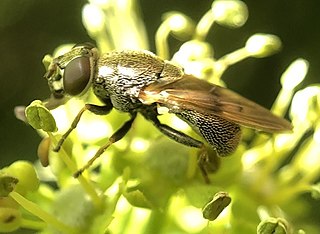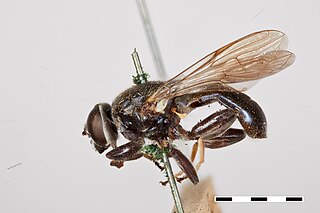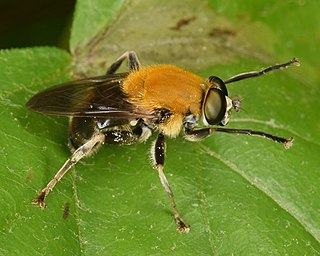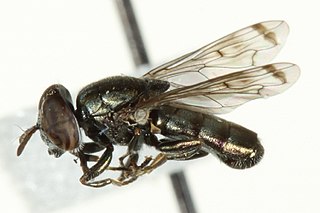
Loews Cineplex Entertainment, also known as Loews Incorporated, is an American theater chain operating in North America. From 1924 to 1959, it was the parent company of Metro-Goldwyn-Mayer Studios (MGM). It was formerly jointly owned by Sony Pictures and Universal Studios and operated theatres in the United States, Canada, South Korea, Spain and Mexico.

Spilomyia is a genus of hoverflies. Many species in the genus show Batesian mimicry of wasp models, including black and yellow patterns and modified antenna shape.

Dasypogoninae is a subfamily of robber flies in the family Asilidae. There are more than 60 genera and 520 described species in Dasypogoninae.

Myolepta is a cosmopolitan genus of hoverflies most closely related to the genus Lepidomyia
Conophorus is a genus of bee flies in the family Bombyliidae. There are at least 16 described species in Conophorus in the United States, and 67 total worldwide.

Myolepta strigilata, the Scaled Pegleg, is an uncommon species of syrphid fly observed in the eastern and central United States. Hoverflies can remain nearly motionless in flight. The adults are also known as flower flies for they are commonly found on flowers, from which they get both energy-giving nectar and protein-rich pollen. The larvae of this genus have been found in rot holes of deciduous trees.

'Spilomyia fusca , the Bald-faced Hornet Fly, is a fairly common species of syrphid fly first officially described by Loew, 1864 This species is found in North Eastern America. Hoverflies get their names from the ability to remain nearly motionless while in flight. The adults are also known as flower flies for they are commonly found around and on flowers from which they get both energy-giving nectar and protein rich pollen. The larvae are known as the short-tailed larva taylored for moist areas such as rot holes of trees.

Myolepta nigra , the Black Pegleg , is an uncommon species of syrphid fly observed in the eastern and central United States and Eastern Canada. Hoverflies can remain nearly motionless in flight. The adults are also known as flower flies for they are commonly found on flowers from which they get both energy-giving nectar and protein-rich pollen. The larvae of this genus are found in the rotholes of deciduous trees.

Temnostoma alternans , the Wasp-like falsehorn, is a common species of syrphid fly observed throughout the northern and central United States and widespread in Canada. Hoverflies can remain nearly motionless in flight. The adults are also known as flower flies for they are commonly found on flowers, from which they get both energy-giving nectar and protein-rich pollen. Larvae burrow in moist decayed wood.

Brachypalpus oarus, the Eastern Catkin, is a common species of syrphid fly first officially described by Walker in 1849. Hoverflies get their names from the ability to remain nearly motionless while in flight. The adults are also known as flower flies for they are commonly found around and on flowers, from which they get both energy-giving nectar and protein-rich pollen. The larvae are of the rat-tailed type feeding on decaying sap under tree bark.

Pterallastes thoracicus , the Goldenback Fly, is an uncommon species of syrphid fly observed across central and eastern areas of the United States. Hoverflies can remain nearly motionless in flight while many are mimics of bees. The adults are also known as flower flies for they are commonly found on flowers, from which they get both energy-giving nectar and protein-rich pollen. The larvae are unknown.
Lejota aerea , the Golden Trunksitter , is an uncommon species of syrphid fly observed in eastern North America. Hoverflies can remain nearly motionless in flight. The adults are also known as flower flies for they are commonly found on flowers, from which they get both energy-giving nectar and protein-rich pollen. The larvae of this genus are found in decaying tree roots.
Lejota is a genus of syrphid flies in the family Syrphidae.
Sphegina lobata , the Yellow-lobed Pufftail, is an uncommon species of syrphid fly observed in notheastern North America. Hoverflies can remain nearly motionless in flight. The adults are also known as flower flies for they are commonly found on flowers, from which they get both energy-giving nectar and protein-rich pollen. Larvae found in accumulations of decaying sap under bark, usually in wet situations such as damp, shaded woodland and in partially submerged wood in streams and pools.

Sphegina rufiventris, the Black-horned Pufftail, is a common species of syrphid fly observed in the northestern United States. Hoverflies can remain nearly motionless in flight. The adults are also known as flower flies for they are commonly found on flowers, from which they get both energy-giving nectar and protein-rich pollen. Larvae are found in accumulations of decaying sap under bark, usually in wet situations such as damp, shaded woodland and in partially submerged wood in streams and pools.

Orthonevra nigrovittata (Loew, 1876), the black-lined mucksucker, is a rare species of syrphid fly. It has been observed in California. Hoverflies get their names from the ability to remain nearly motionless while in flight. The adults are also known as flower flies for they are commonly found around and on flowers from which they get both energy-giving nectar and protein rich pollen. Larvae for this genus are of the rat-tailed type. O. nigrovittata larvae have not been described.

Parhelophilus integer , the shiny bog fly, is a rare species of syrphid fly observed in the Eastern United States. Hoverflies can remain nearly motionless in flight. The adults are also known as flower flies, for they are commonly found on flowers from which they get both energy-giving nectar and protein-rich pollen. The larvae of this genus are the long tailed "rat-tailed" type.
Parhelophilus divisus the yellow-legged bog fly, is a rare species of syrphid fly observed in the northeastern United States. Hoverflies can remain nearly motionless in flight. The adults are also known as flower flies for they are commonly found on flowers, from which they get both energy-giving nectar and protein rich pollen. The larvae are the long tailed "rat-tailed" type.
Heringia calcarata, the opaque spikeleg, is an uncommon species of syrphid fly observed in North America Hoverflies can remain nearly motionless in flight. The adults are also known as flower flies for they are commonly found on flowers from which they get both energy-giving nectar and protein rich pollen. Larvae are aphid predators.












